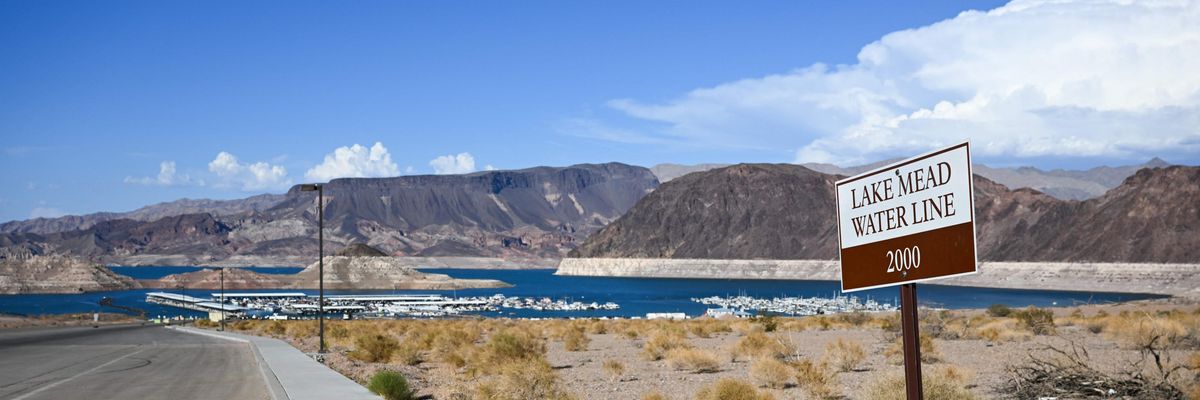As the dwindling Colorado River faces a potential "catastrophic collapse" due to the climate-driven loss of trillions of gallons of water, a report published Tuesday shines a spotlight on the dangerous overexploitation of the precious resource by specific sectors of industrial agriculture—and the federal government's failure to address Big Ag's abuses.
The Food & Water Watch report—entitledBig Ag Is Draining the Colorado River Dry—focuses on how "alfalfa farms and the aggressive proliferation of megadairies" are "sucking the Colorado dry," and on "prolonged governmental refusal to rein in the most egregious offenders."
According to the report, "livestock feed crops remain the largest consumers of water in the Colorado River Basin, accounting for 55% of all water used." Among these, alfalfa "consumed 2.2 trillion gallons of water across the seven basin states in 2022 alone."
"This is enough water to meet the indoor household needs of all the nearly 40 million people who rely on the Colorado River system for water for three-and-a-half years," the publication states.
The paper notes that the Almarai Company, a Saudi multinational, "owns 10,000 acres of Arizona farmland, cultivating alfalfa to support dairies in Saudi Arabia; the country banned alfalfa cultivation in 2018 in order to conserve water."
"We cannot save the Colorado River without combating corporate power," the report asserts. "The Colorado River is deeply in crisis, and the solutions are already known."
The Food & Water Watch publication continues:
The arid U.S. West cannot sustain the factory farm system as water shortages continue. States must immediately de-prioritize wasteful industries such as large-scale alfalfa, nut trees, and megadairies. Each of these only contributes to worsening drought and climate change along the river, and continuing along this path only leads to harming communities and ecosystems that are struggling to survive in a hotter climate.
The report recommends:
- Passing the Farm System Reform Act (FSRA), which would put a moratorium on new and expanding factory farms and help transition dairy farmers away from factory farms;
- Restricting federal conservation dollars from being used to prop up factory farms and alfalfa acreage;
- Limiting alfalfa exports;
- Banning new megadairies and the expansion of existing ones;
- Stopping new and expanding large-scale tree nut and alfalfa acreage;
- Helping transition small and medium-sized growers to more geographically appropriate and resilient crops; and
- Improving water management practices by defining all water as a public trust resource, not a commodity subject to resource extraction at the expense of the public.
"Without drastic changes, the Colorado River Basin will become increasingly unlivable for tens of millions of people across seven states," Food & Water Watch research director Amanda Starbuck said in a statement. "Ultimately, water is a public resource, not a commodity, and should be treated as such."
Food & Water Watch's report comes ahead of an August 15 deadline for public comment on the Biden administration's proposal to cut water allotments to basin states—a plan the group said fails to tackle Big Ag's resource abuse.
The Colorado River historically ran about 1,450 miles from its headwaters high in the Rocky Mountains of northern Colorado through Utah, the Grand Canyon in Arizona, and along Nevada and California's southeastern borders before flowing into the northernmost tip of the Gulf of California in Mexico.
The river—which long sustained Indigenous peoples both before and after the genocidal colonization of the Southwest—provides water to around 40 million people in seven Western states and about 30 Native American tribes.
Western states started allocating the river's water between them in the early 20th century, while massive dams and channels diverted water hundreds of miles away to thirsty desert farms and sprawling cities like Los Angeles, Phoenix, San Diego, and Las Vegas.
"Ultimately, water is a public resource, not a commodity, and should be treated as such."
The Colorado River Compact established annual water allocations that member states must use in full or face usage-based cuts the following year. This "use it or lose it" system has created what critics call "perverse" incentives for farmers to grow nonessential, water-intensive crops like alfalfa and grass for cattle grazing in the middle of the desert.
Around 75% of the Colorado River's flow is currently diverted to irrigate more than 5 million acres of farmland, according to the U.S. Bureau of Reclamation. Hydroelectric plants along the river also generate more than 12 billion kilowatt hours of annual electricity.
Despite heavier-than-average snow and rainfall last winter, the Colorado River has been running perilously low in recent years as worsening droughts driven by the climate emergency have gripped the Southwest and as the population of the nation's driest region explodes. The river no longer reaches the sea, and models predict that its flow may be further halved by 2100.

